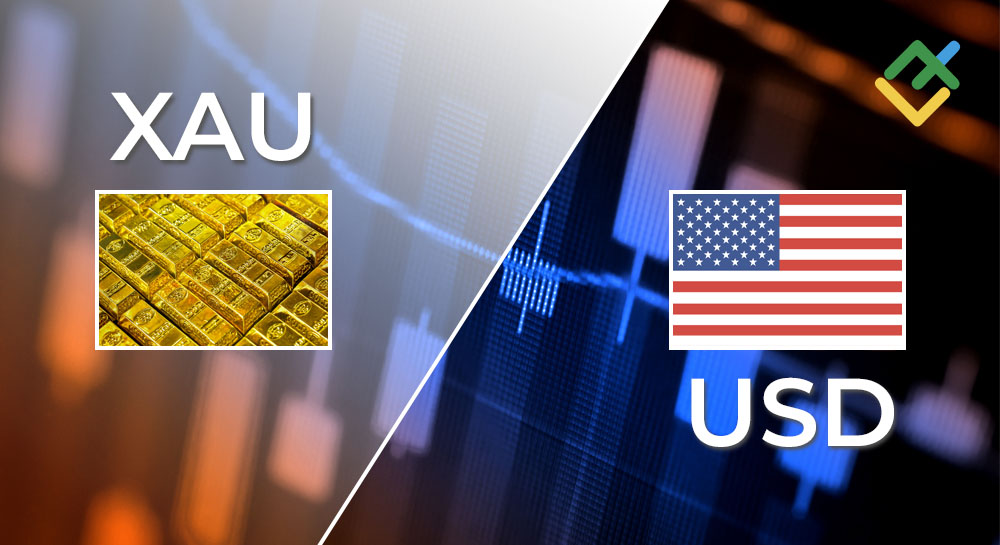
Market expectations for two Fed rate cuts this year remain largely the same. Despite the Fed’s new forecasts regarding the outlook for monetary policy, which includes an interest rate cut in Scenario 1 in 2024, markets are expecting the first cut in September and another in November. The next Fed meeting is scheduled for the end of this month. As the Fed Chairman Jerome Powell has previously repeatedly warned, the decision on interest rates will depend on incoming macro data and inflation dynamics.
The next inflation data will be presented on Thursday, July 11. This publication is likely to become the central point of the week 08.07.2024 – 14.07.2024. One way or another, inflation in the United States is still significantly above the 2% Fed target, which makes dollar sellers cautious about its sales.
The dollar and its DXY index ended the first half of the year with an increase of approximately 4%, as we noted in our previous review. So far, there are still no grounds for large-scale sales of the dollar.
In the coming week, market participants will also pay attention to the publication of important macro statistics from China, Germany and the results of the meeting of the RB of New Zealand.
Note: During the coming week, new events may be added to the calendar and / or some scheduled events may be cancelled. Time is GMT
The article covers the following subjects:
Key facts
- Monday and Tuesday: No important macroeconomic statistics publications.
- Wednesday: China’s CPI is forecast to decline to 0.2% y/y. It is expected that the RB of New Zealand will leave the rate at 5.5%.
- Thursday: Germany’s HICP is likely to remain at 6.4% y/y.
- Friday: No important publications.
- Central event of the week: US inflation data is forecast to show a slowdown to 3.1% y/y, which may affect the Fed’s rate decisions.
Monday, July 8
No important macro statistics scheduled to be released.
Tuesday, July 9
No important macro statistics scheduled to be released.
Wednesday, July 10
01:30 CNY Consumer Price Index (CPI)
The National Bureau of Statistics of China will present regular monthly data reflecting the dynamics of consumer prices in China. Rising consumer prices could trigger an acceleration in inflation, which could force the People’s Bank of China to take measures aimed at tightening fiscal policy. Increased growth in consumer inflation may cause the yuan to appreciate, and a weak result will put pressure on the yuan.
China’s economy is the second largest in the world after America’s. Therefore, the publication of important macroeconomic indicators of this country has a noticeable impact on global financial markets, primarily on the positions of the yuan, other Asian currencies, the dollar, commodity currencies, as well as on Chinese and Asian stock indices. China is the largest buyer of raw materials and a supplier of a wide range of finished products to the global commodity market.
In May 2024, the value of the consumer inflation index was -0.1% (+0.3% in annual terms), +0.1% (+0.3% in annual terms) in April, +0.1% (- 2.7% in annual terms) in December 2023, -0.5% (-0.5% in annual terms) in November, +0.2% (0% in annual terms) in September, in July + 0.3% (+0.1% in annual terms), in June -0.2% (0% in annual terms), in May -0.2% (+0.2% in annual terms).
An increase in the consumer inflation index will have a positive effect on the quotations of the yuan, as well as commodity currencies. However, worse-than-forecast data and a relative decline in CPI may have a negative impact on them. This applies to a greater extent to the Australian dollar, since China is Australia’s largest trade and economic partner.
02:00 NZD The RB of New Zealand’s decision on the interest rate. RBNZ’s monetary policy statement
Following the meetings held in October and November 2021, the Reserve Bank of New Zealand (for the first time in 7 years) raised the key interest rate to 0.50% and then to 0.75%. The interest rate was raised again to 1.5% in February and April 2022 to ease inflation and contain rapidly rising house prices. Currently the RBNZ interest rate is 5.50%.
The RBNZ previously stated that the economy no longer needed the current level of monetary stimulus.
In May 2024, the RBNZ again kept the official cash rate at 5.50% for the seventh time in a row. The RBNZ stated the need for monetary policy to remain restrictive to maintain downward pressure on inflation. Bank managers need to find a balance while annual inflation hovers around 4.0%, well above the target of 1.0% – 3.0%.
At this meeting, the RBNZ may either raise the interest rate again, and its leaders may also speak out in favor of further increasing the interest rate at subsequent meetings, or leave the rate at the current level. Market participants monitoring the NZD quotes should be prepared for a sharp increase in volatility during this time period.
In the accompanying statement and comments, the RBNZ management will provide an explanation of the interest rate decision and comments on the economic conditions that contributed to this decision.
At this time, volatility in New Zealand dollar quotes may increase sharply.
Note that at the end of the July 2023 meeting, the leaders of the Central Bank of New Zealand kept the interest rate at 5.50%. This was the first pause since the RBNZ began tightening monetary policy in August 2021. In the accompanying statement, the RBNZ noted that the current parameters of monetary policy are already restrictive.
Thursday, July 11
06:00 EUR Harmonized Index of Consumer Prices in Germany (final estimate)
The Harmonized Index of Consumer Prices (HICP) is published by the EU Statistics Office and is calculated based on a statistical method agreed between all EU countries. It is an indicator for assessing inflation and is used by the Governing Council of the ECB to assess the level of price stability. A positive result strengthens the EUR, a negative result weakens it.
Previous indicator values: +2.8%, +2.4%, +2.3%, +2.7%, +3.1% in January 2024, +3.8% in December, +2.3 % in November, +3.0% in October, +4.3% in September, +6.4% in August, +6.5% in July, +6.8% in June, +6.3% in May, +7.6% in April, +7.8% in March, +9.3% in February, +9.2% in January, +9.6% in December, +11.3% in November, +11.6% in October, +10.9% in September, +8.8% in August, +8.5% in July, +8.2% in June, +8.7% in May, +7 .8% in April, +7.6% in March, +5.5% in February, +5.1% in January 2022 (in annual terms).
The data suggests inflation in Germany continues to slow, albeit at a slower-than-expected pace, which in turn puts pressure on the ECB to ease its monetary policy. Data weaker than the previous value will likely have a negative impact on the euro. And, conversely, the resumption of inflation growth could provoke a strengthening of the euro. The growth of the indicator is a positive factor for the euro.
If the data for June turns out to be better than previous values, the euro may strengthen in the short term.
12:30 USD Consumer price indices
Consumer Price Index (CPI) determines changes in the prices of a selected basket of goods and services over a given period and is a key indicator for assessing inflation and changes in consumer preferences. Food and energy are excluded from the Core CPI to provide a more accurate estimate.
A high result strengthens the US dollar because the likelihood of a Fed rate hike increases, while a low result weakens it.
Previous values (annualized):
- CPI: +3.3%, +3.4%, +3.5%, +3.2%, +3.1%, +3.4%, +3.1% +3.2%, + 3.7%, +3.7%, +3.2%, +3.0%, +4.0%, +4.9%, +5.0%, +6.0%, +6, 4% (in January 2023),
- Core CPI: +3.4%, +3.6%, +3.8%, +3.8%, +3.9%, +3.9%, +4.0%, +4.0% , +4.1%, +4.3%, +4.7%, +4.8%, +5.3%, +5.5%, +5.6%, +5.5%, + 5.6% (in January 2023)
The data presented indicate a continued slowdown in consumer inflation, although at a slower pace than expected by the Fed. It’s also well below 2022, when annual US inflation hit a 40-year high of 9.1% in June. On the other hand, US inflation is still well above the Fed’s target level of 2%, which will force US Central Bank officials to maintain interest rates at high levels.
If the data is confirmed or turns out to be weaker than forecast, the dollar will most likely react with a short-term decline. The stronger-than-expected data will strengthen the dollar, as it will increase the likelihood of the Fed keeping interest rates at high levels for a longer period of time.
Friday, July 12
06:00 EUR Retail sales
Retail sales are the main indicator of consumer spending in Germany showing changes in the volume of sales in the retail sector. A high result strengthens the euro, and vice versa, a low result weakens it.
Previous values: -1.2% (-0.6% in annual terms), +1.8% (+0.3% in annual terms), -1.9% (-2.7% in annual terms) , -0.4% (-1.4% in annual terms) in January 2024, -1.6% (-1.7% in annual terms), -2.5% (-2.4% in annual terms), +1.1% (-0.1% in annual terms), -0.8% (-4.3% in annual terms), -1.2% (-2.3% in annual terms) , -0.8% (-2.2% in annual terms), -0.8% (-1.6% in annual terms), +0.4% (-2.1% in annual terms), + 0.8% (-4.3% in annual terms), -2.4% (-8.6% in annual terms), -1.3% (-7.1% in annual terms), -0, 3% (-3.8% in annual terms) in January 2023.
The data shows an uneven recovery and, in some months, a slowdown in this sector of the German economy. Data better than the forecast and/or the previous value will likely have a positive impact on the euro, but in the short term.
12:30 USD Producer Price Index (PPI)
Producer Price Index estimates the average change in wholesale prices determined by manufacturers at all stages of production. It is one of the leading measures of inflation in the United States, measuring the average change in wholesale producer prices.
As rising production costs increase wholesale prices, this ultimately increases consumer inflation. An increase in inflation (in normal economic conditions) usually puts upward pressure on the quotes of the national currency, since it implies a tighter monetary policy of the Central Bank.
Previous values: -0.2% (+2.2% in annual terms) in May, +0.5% (+2.2% in annual terms) in April, +0.2% (+1.6% in annual terms) in March, +0.6% (+1.6% in annual terms) in February, +0.3% (+0.9% in annual terms) in January 2024, 0% (+0 .9% in annual terms) in December 2023, -0.5% (+1.3% in annual terms), +0.5% (+2.2% in annual terms), +0.7% ( +1.6% in annual terms), +0.3% (+0.8% in annual terms), +0.1% (+0.2% in annual terms), -0.3% (+0 .9% in annual terms), +0.2% (+2.3% in annual terms), -0.5% (+2.7% in annual terms), -0.1% (+4.9 % in annual terms), +0.7% (+5.7% in annual terms) in January 2023.
If the data turns out to be better than expected (above forecast values), the dollar is likely to strengthen. And, conversely, data below the forecast and previous values will put pressure on the Fed when it makes its next decision on monetary policy in the direction of easing, which will have a negative impact on the dollar.
14:00 USD University of Michigan Consumer Confidence Index (preliminary release)
This indicator reflects the confidence of American consumers in the country’s economic development. A high level indicates economic growth, while a low level indicates stagnation. Previous indicator values: 68.2 in June, 69.1 in May, 77.2 in April, 79.4 in March, 76.9 in February, 79.0 in January 2024, 69.7 in December 2023, 61.3 in November, 63.8 in October, 68.1 in September, 69.5 in August, 71.6 in July, 64.4 in June, 59.2 in May, 63.5 in April, 62. 0 in March, 67.0 in February, 64.9 in January 2023, 59.7 in December, 56.8 in November, 59.9 in October, 58.6 in September, 58.2 in August, 51, 5 in July, 50.0 in June, 58.4 in May, 65.2 in April, 59.4 in March, 62.8 in February, 67.2 in January 2022. An increase in the indicator will strengthen the USD, and a decrease in the value will weaken the dollar. Data indicate an uneven recovery of this indicator, which is negative for the USD. Data worse than previous values may have a negative impact on the dollar in the short term.
Price chart of EURUSD in real time mode
The content of this article reflects the author’s opinion and does not necessarily reflect the official position of LiteFinance. The material published on this page is provided for informational purposes only and should not be considered as the provision of investment advice for the purposes of Directive 2004/39/EC.
{{value}} ( {{count}} {{title}} )
This post is originally published on LITEFINANCE.



